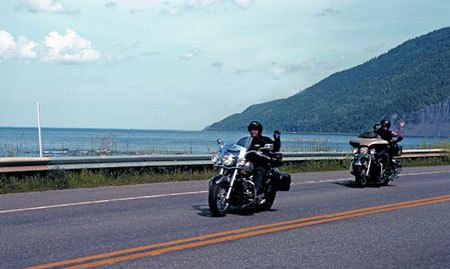Exploring Quebec Maritime

Exploring new places on a motorcycle is one of the main reasons many of us took up the two-wheeled pastime in the first place. But what if you’re already seen everything there is to see in your neck of the woods? A trip to Europe would be nice, but now we’re talking about spending a lot of money on cross-continental airfare and you can’t bring your motorcycle with you. Fortunately, there is a place that many of you can drive to where you can enjoy a European-type experience for a fraction of the cost – Quebec.
At first glance Canada is very similar to the United States in a lot of ways, but Quebec offers something different entirely. Not only is French the first language of choice for many Quebecers, but riding through province offers a very European vibe. From the big metropolitan centers like Montreal and Quebec City to the small fishing towns that dot the St. Lawrence River, it’s an experience you just can’t find anywhere else without crossing the Atlantic.
This is the first in a series of articles we’re doing about motorcycling in Quebec. Here we’ll talk about a handful of different areas of the province that are ripe for motorcycle exploration.
The Gaspésie Tour
The Gaspésie Tour takes you to the southeast part of Quebec known as the Gaspé Peninsula. The tour offers 1,000 kilometres (621 miles) of coastal roads that have to be seen to be believed.
La Pocatière is the starting point of the tour, which is where the St. Lawrence River starts to widen into the Atlantic. From there you’ll head east along the coastline through the villages in the Kamouraska region and to the Bic National Park.
Continue on to the region of Sainte-Flavie before heading south towards the beautiful Chaleur Bay and the fossil-rich Miguasha National Park. As you continue on you’ll go from village to village, seeing the diverse culture of Gaspésie – English Loyalists, Acadians, the Basque, the Irish, and Aboriginal people. This small area offers a cultural mosaic like few other spots on the planet.
On the eastern point of the peninsula is Forillon National Park. Forillon boasts Canada’s tallest lighthouse and you can go on whale-watching excursions that depart from Gaspé Bay. South of Forillon is Percé and from there you’ll see Bonaventure Island and Percé Rock National Park – an area that is home to 300,000 marine birds.
The tour now heads westward, but this time along the southern part of the peninsula. Here you’ll see a myriad of lighthouses and Gaspésie National Park. If you’ve got the energy, throw on your hiking boots and keep an eye out for caribou as you venture to Mt. Albert or Mt. Jacque-Cartier.
The Whale Route
The Whale Route takes you north of the Gaspe Peninsula and along the north shore of the St. Lawrence River in Côte-Nord for 1,250 kilometres (775 miles). As the name implies, this is one of the world’s best whale-watching destinations. Try to see how many of the 13 species of whales that inhabit this area you can spot. You can see whales from the shore, but to get up close and personal, park your bike and take a boat tour or even rent a sea kayak for the ultimate experience.
The Whale Route begins in Tadoussac – home to the panoramic Tadoussac Bay. It is also one of the gateways to Saguenay National Park. Though this area is home to many natural marvels, there is one man-made structure that shouldn’t be missed – Manic-5 – the largest multiple-arch and buttress dam in the world.
One of Quebec’s most beautiful lighthouses awaits you in Pointe-des-Monts offers its archipelago for you to enjoy. Further east the Whale Route ends in Natashquan.
During eastern part of the tour you will be able to spot Anticosti, a nearly uninhabited island that is the size of a small country and home to a national park. There is but one municipality on Anticosti – Port-Menier – where white-tailed deer are so abundant they can be seen walking along the street.
Îles de la Madeleine
If you just want to get away, Îles de la Madeleine might be the perfect place to go. Have some fun in Montreal for a couple of days before hopping on a ferry cruise to this isolated archipelago made up of seven inhabited islands. Six of these islands are linked by the main road, Route 199, which should make for an inspiring summer motorcycle ride.
Despite being well off the mainland, you’ll find plenty of lodging choices, including hotels, B&Bs, cottages and campgrounds.
The Islands’ memorable red cliffs are dotted with caves and sea arches. You can explore them by sea kayak or in a wetsuit if you’re accompanied by an experienced guide.
This is a culture-rich area, so you’ll find a myriad of art studios, galleries, and boutiques. Of course, food is an art in and of itself here and you can sample fresh lobster and a wide variety of other local treats.
National Parks and Wildlife Reserves
We’ve mentioned several already, but Quebec maritime is home to nine national parks. Much of this part of the province is sparsely populated, making it a virtual paradise for nature loves. Beyond the breathtaking scenery, wildlife of all kinds is on display at every turn.
From hiking high into the mountains to exploring the shoreline, the parks are full of history and adventure just waiting to be discovered.

Motorcycle.com presents an unrivaled combination of bike reviews and news written by industry experts
More by Motorcycle.com Staff
































Comments
Join the conversation